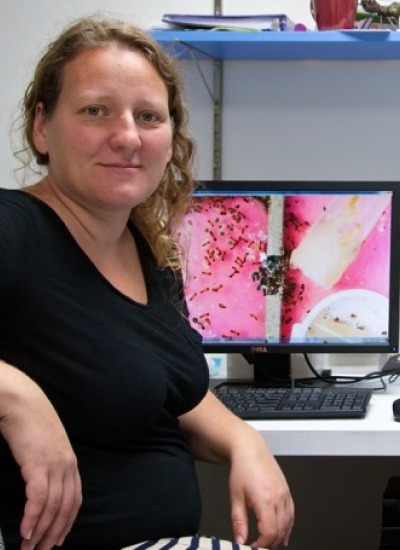Anna R Dornhaus
Publications
PMID: 16849234;PMCID: PMC1578745;Abstract:
Many natural and artificial decision-making systems face decision problems where there is an inherent compromise between two or more objectives. One such common compromise is between the speed and accuracy of a decision. The ability to exploit the characteristics of a decision problem in order to vary between the extremes of making maximally rapid, or maximally accurate decisions, is a useful property of such systems. Colonies of the ant Temnothorax albipennis (formerly Leptothorax albipennis) are a paradigmatic decentralized decision-making system, and have been shown flexibly to compromise accuracy for speed when making decisions during house-hunting. During emigration, a colony must typically evaluate and choose between several possible alternative new nest sites of differing quality. In this paper, we examine this speed-accuracy trade-off through modelling, and conclude that noise and time-cost of assessing alternative choices are likely to be significant for T. albipennis. Noise and cost of such assessments are likely to mean that T. albipennis' decision-making mechanism is Pareto-optimal in one crucial regard; increasing the willingness of individuals to change their decisions cannot improve collective accuracy overall without impairing speed. We propose that a decentralized control algorithm based on this emigration behaviour may be derived for applications in engineering domains and specify the characteristics of the problems to which it should be suited, based on our new results. © 2005 The Royal Society.
Abstract:
Within-group conflict may influence the degree to which individuals within a group cooperate. For example, the most dominant individuals within a group often gain access to the best resources and may be less inclined to perform risky tasks. We monitored space use and division of labor among all workers in three colonies of bumblebees, Bombus impatiens, during the ergonomic and queenless phases of their colony cycle. We then measured the two largest oocytes in each worker to estimate each individual's reproductive potential at the end of the colony cycle. We show that workers that remained farther from the queen while inside the nest and avoided risky or more energy-expensive tasks during the ergonomic phase developed larger oocytes by the end of the colony cycle. These individuals also tended to be the largest, oldest workers. After the queen died, these workers were more likely than their nestmates to increase brood incubation. Our results suggest that inactive bumblebees may be storing fat reserves to later develop reproductive organs and that the spatial organization of workers inside the nest, particularly the distance workers maintain from the queen, may predict which individuals will later have the greatest reproductive potential in the colony. © 2011 Springer-Verlag.
Abstract:
Social insects like ants and bees live in cooperative colonies containing up to millions of individuals. These colonies are sometimes termed 'superorganisms' and have evolved tightly integrated and sophisticated collective behaviours. Different species, however, often differ in the type and mechanisms of communication and collective organization employed. I show here how individual-based models can be used to identify the non-intuitive benefits of different mechanisms of communication and division of labour and how these benefits may depend on the external environment as well as traits of the society itself. This allows us to understand under what ecological conditions particular types of collective organization may have evolved, and thus can also help to explain variation among species. © 2012 Copyright Taylor and Francis Group, LLC.
Abstract:
A honey bee colony (Apis mellifera Linnaeus) frequently adjusts its nectar foraging effort to changes in foraging conditions. It is possible that workers use a volatile substance, e.g. a pheromone, to quickly activate foragers in all regions of the hive. To test whether volatiles from a foraging colony can activate foragers of a non-foraging colony, two colonies, each restricted to a different greenhouse, were connected with a glass tube that allowed volatiles to drift between colonies. During the experiment, one colony was allowed to forage unscented sugar water. The scent of the foraging colony was fanned into the colony that did not have sugar water available, and the number of times that workers each left the hive and arrived at the empty feeder station was recorded. The number of visits of the empty feeder by foragers from the non-foraging colony tended to increase, while the number of times that bees left the hive did not seem to change. The result suggests an increase in foraging motivation of already active foragers. However, the results will have to be corroborated by further experiments. © 2007 E. Schweizerbart'sche Verlagsbuchhandlung.


